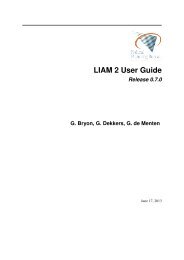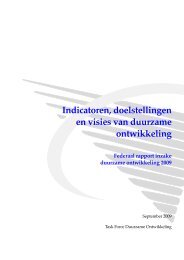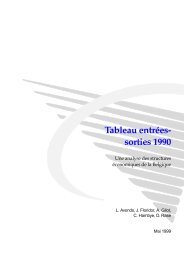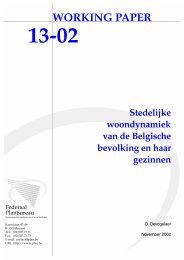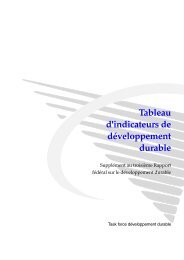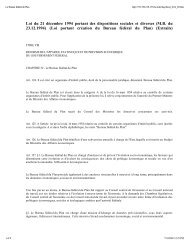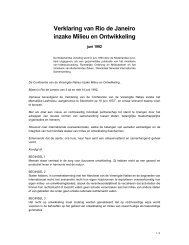long-term care use and supply in europe: projections for germany ...
long-term care use and supply in europe: projections for germany ...
long-term care use and supply in europe: projections for germany ...
Create successful ePaper yourself
Turn your PDF publications into a flip-book with our unique Google optimized e-Paper software.
LONG-TERM CARE USE AND SUPPLY IN EUROPE | 35<br />
N<strong>for</strong>m ,,,,,, Nh<strong>for</strong>m ,,,,,, Nres ,,,,,,<br />
(9)<br />
Total numbers of <strong>in</strong><strong>for</strong>mal <strong>care</strong> <strong>use</strong>rs by age, gender, disability <strong>and</strong> other characteristics Nh<strong>in</strong>f a,g,d,h,e,o,t<br />
are calculated by summ<strong>in</strong>g the numbers of persons us<strong>in</strong>g <strong>in</strong><strong>for</strong>mal <strong>care</strong> only <strong>and</strong> the numbers of persons<br />
comb<strong>in</strong><strong>in</strong>g <strong>for</strong>mal <strong>and</strong> <strong>in</strong><strong>for</strong>mal <strong>care</strong>:<br />
Nh<strong>in</strong>f ,,,,,, Nh<strong>care</strong> IC,,,,,,, Nh<strong>care</strong> FIC,,,,,,,<br />
(10)<br />
The total number of LTC <strong>use</strong>rs <strong>for</strong> a certa<strong>in</strong> <strong>care</strong> category j <strong>and</strong> a given year t is calculated by summ<strong>in</strong>g<br />
the numbers of <strong>use</strong>rs over all cells.<br />
N N ,,,,,,,<br />
,,,,,<br />
with j=category of <strong>care</strong>: no <strong>care</strong> (NC), residential <strong>care</strong> (RES), <strong>for</strong>mal home <strong>care</strong> only (FC),<br />
<strong>in</strong><strong>for</strong>mal home <strong>care</strong> only (IC), both <strong>for</strong>mal <strong>and</strong> <strong>in</strong><strong>for</strong>mal home <strong>care</strong> (FIC)<br />
(11)<br />
4.2 Base <strong>and</strong> alternative scenarios<br />
The future number of <strong>care</strong> <strong>use</strong>rs will be affected by future trends <strong>in</strong> de<strong>term</strong><strong>in</strong>ants of <strong>care</strong> utilisation. This<br />
section first describes the assumptions of the base scenario about trends <strong>in</strong> disability, ho<strong>use</strong>hold<br />
composition <strong>and</strong> other driv<strong>in</strong>g factors. Next, alternative scenarios, explor<strong>in</strong>g the sensitivity of the<br />
<strong>projections</strong> to alternative assumptions about disability <strong>and</strong> socio-demographic trends, are discussed.<br />
Eleven alternative disability scenarios have been <strong>for</strong>mulated by NIDI as part of WP 2 of the ANCIEN<br />
project (see Bonneux et al., 2011): Four bio-demographic scenarios, explor<strong>in</strong>g the effect of different<br />
relationship between the <strong>in</strong>cidence of disability <strong>and</strong> mortality, <strong>and</strong> seven risk factor scenarios, explor<strong>in</strong>g<br />
the effect of obesity <strong>and</strong> smok<strong>in</strong>g. Furthermore, <strong>in</strong> this chapter, two alternative socio-demographic<br />
scenarios are <strong>for</strong>mulated, one explor<strong>in</strong>g the effect of ho<strong>use</strong>hold composition changes, another one<br />
explor<strong>in</strong>g the effect of a higher educational level <strong>in</strong> future cohorts of older persons.<br />
In all scenarios, probabilities of <strong>care</strong> <strong>use</strong> by age, gender, disability <strong>and</strong> other relevant characteristics, as<br />
estimated <strong>for</strong> the base year, are assumed to rema<strong>in</strong> constant over the projection horizon. This implies<br />
that <strong>use</strong> of <strong>care</strong> will be constra<strong>in</strong>ed by <strong>supply</strong> factors (<strong>in</strong>clud<strong>in</strong>g availability <strong>and</strong> accessibility of services,<br />
the fund<strong>in</strong>g system, <strong>and</strong> the policy <strong>in</strong>centives or dis<strong>in</strong>centives to provide <strong>in</strong><strong>for</strong>mal <strong>care</strong>) to a similar<br />
extent <strong>in</strong> the future than it is <strong>in</strong> the base year (Comas-Herrera et al., 2003).<br />
4.2.1 Base scenario assumptions<br />
The base scenario <strong>use</strong>s the WP 2 <strong>projections</strong> of the older population by age category, gender <strong>and</strong><br />
disability level from the NIDI DELAY scenario. This scenario assumes that disability <strong>in</strong>cidence is<br />
delayed to older ages with the same amount of time as mortality is delayed (see Bonneux et al., 2011). It<br />
has been chosen as base scenario, as it is an <strong>in</strong><strong>term</strong>ediate scenario between more pessimistic scenarios<br />
assum<strong>in</strong>g constant prevalence (PREV scenario) or constant <strong>in</strong>cidence (CHRON scenario) of disability<br />
<strong>and</strong> the more radical optimistic BIOL scenario (see 4.2.2).<br />
With regard to ho<strong>use</strong>hold composition the base scenario assumes the basel<strong>in</strong>e proportions of older<br />
persons liv<strong>in</strong>g alone or with others by age, gender <strong>and</strong> disability to rema<strong>in</strong> constant over the projection<br />
horizon. Likewise, the estimated base year distribution over educational level, by age, gender, disability<br />
<strong>and</strong> ho<strong>use</strong>hold composition, is assumed to rema<strong>in</strong> constant over the projection period, as is the further<br />
distribution of the older population over the other model characteristics (IADL limitations, cognitive<br />
function<strong>in</strong>g, <strong>in</strong>come, hav<strong>in</strong>g children). Assum<strong>in</strong>g ho<strong>use</strong>hold composition <strong>and</strong> educational levels to



